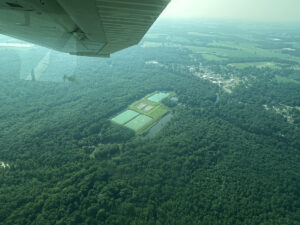News


A major algal bloom on the south side of the Pamlico River, from Durham Creek west to likely Blounts Bay, was reported Wednesday. The river is described as being “florescent green,” which is a sure sign of a problem.
By Thursday morning, it was worse, as reports of hundreds of dead fish in Durham Creek alone were reported, including larger species such as black bass. Excess nutrients, hot conditions and upwelling from strong winds yesterday are the likely culprits.
North Carolina Department of Environmental Quality is investigating.
In the meantime, keep your people and pets out of discolored water and areas where dead fish are found. There are types of algal blooms that can produce toxins, but until test results are returned, we do not know if toxins are present. To be safe, avoid contact with the water.
Read what DEQ discovered about this algal bloom here.
ABOUT HARMFUL ALGAL BLOOMS
As the temperatures rise at the end of summer, residents should be on the lookout and stay away from green waterways. The cause is HABs — harmful algal blooms — that can be dangerous.
HABs are naturally occurring microbiotic bacteria (commonly referred to as “blue-green algae”) that turn our slow-moving waters into toxic pools of water for people and can even kill pets.
Why does the water turn green?
Algal blooms are due to excess nutrients from farm and urban runoff pouring into waterways. Cyanobacteria can produce cyanotoxins, which are the most dangerous impact on our drinking water and endanger human health, fish and animals.
Algal growth is caused by numerous factors, including available nutrients, water-flow rates and water temperature. The combination of higher temperatures and climbing nutrient loads in many North Carolina waterbodies means that algal blooms will continue to increase.
Many will likely remember the brutally hot summer of 2016, when the Pamlico River and many of its tributaries turned a shade of green not seen in decades and people were warned to stay out of the water. It’s happened again on the south side of the Pamlico, with reports of “florescent green” water from Hickory Point-Durham Creek west to Blounts Bay.
The Chowan River, another eastern North Carolina waterway, has experienced recurring HABs for the past several years.
How can you spot HABs?
HABs most often happen in stagnant or slow-moving water in coves and shallow areas. They may turn the water solid green or neon blue-green. HABs sometimes grow on the bottom of the lake or pond and form a thick mat of green or blackish growth on the water’s surface in very stagnant water.
It’s important to note that the water may still have toxins present even after the bloom is gone. Once it has been confirmed that the presence of cyanobacteria and cyanotoxins is gone, it’s safe to go into the water.
What happens when a person or a pet is exposed to contaminated water?
HABs pose threats to humans when we come in contact with cyanotoxin-contaminated water or eat contaminated food from the waterways. According to the EPA, human exposure to elevated levels of cyanotoxins can impact the kidneys, liver and neurological system. According to the EPA, depending on the particular cyanotoxin, symptoms may range from skin, eyes, nose and throat irritation to headache and abdominal pain, to more serious neurological or respiratory system impacts.
Pets that have come into contact with toxic algae or ingested water contaminated with cyanotoxins may also experience adverse health impacts. In 2019, two dogs died near Wilmington after coming into contact with a HAB. Several other pets have been killed across the country due to high concentrations of cyanotoxins in bodies of water caused by HABs. Exposure can cause health impacts that include too much salivation, general weakness, staggered walking and difficulty breathing. In some severe cases, animals exposed to toxic algae may die within hours or days of exposure.
What to do if you see a HAB?
Stay away! Keep away from the water if it looks like a HAB. Coming in contact with the water, eating fish from that water source and letting your pets drink from the water can be very harmful. Visit the Waterkeepers Carolina website for more information about HABs.
Report! Report the HAB to the North Carolina Division of Water Resources citizen report form, and contact us at Sound Rivers: on the Neuse, contact Lower Neuse Riverkeeper Katy Hunt; on the Tar-Pamlico, contact Pamlico-Tar Riverkeeper Jill Howell.
Send us your photos! If you see discolored water or fish kills, take a photo and send it to us, along with the location where the photo was taken. This helps us determine where to take water samples for testing. You can send your photo HERE.
Take Action! Become a Clean Water Warrior to get advocacy alerts and demand better regulations to prevent and manage HABs. Here are a few ways you can pitch in to our clean-water campaign.
Related News

Riverkeeper monitoring Tar-Pamlico Water Trail
July 25th 2024

Rain ramps up trash-trap cleanouts
July 25th 2024

Riverkeeper, intern take on emergency trash trap cleanout
July 25th 2024

Tar-Pam Riverkeeper investigates Cub Creek turbidity
July 25th 2024

Heavy rains lead to sky-high turbidity on Lick Creek
July 25th 2024

Riverkeeper: What goes up, must come down
July 18th 2024

Greenville’s trash trap gets emergency cleanout
July 18th 2024

Sound Rivers gets close up of cyanobacteria
July 18th 2024


